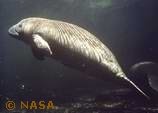Tuesday, August 29, 2006
Manatee Bones Lead Stanford Scientist to New Insight on Evolution
 Most research professors spend their days writing grants, teaching and managing graduate students, so when Stanford's David Kingsley, PhD, ventured from his office to his lab, pulled out a scale and started weighing 114 pairs of manatee pelvic bones, it was a sign that something was afoot.
Most research professors spend their days writing grants, teaching and managing graduate students, so when Stanford's David Kingsley, PhD, ventured from his office to his lab, pulled out a scale and started weighing 114 pairs of manatee pelvic bones, it was a sign that something was afoot.
The results of Kingsley's efforts make his departure from the routine worthwhile. He found that in almost every case, the left pelvic bone outweighed the right. Although seemingly trivial in difference - the average left pelvic bone is a mere 10 percent larger than its right-side partner - that difference carries big weight in evolutionary significance. It suggests that mutations in the same gene may be responsible for the evolution of leglessness in animals as distantly related as 1,000-pound manatees in Florida and fish smaller than an index finger living in lakes and streams around the world.
"It's striking that evolution might use the same mechanism over and over," said Kingsley, professor of developmental biology at the Stanford University School of Medicine and a Howard Hughes Medical Institute investigator. His study will appear in the Aug. 28 advance online issue of the Proceedings of the National Academy of Sciences.
--
The paper didn't actually appear until the 31st (but never mind!): "Parallel genetic origins of pelvic reduction in vertebrates" (Abstract).
Today's New York Times (may require free registration) is also carrying a three-page article on manatees:"Sleek? Well, No. Complex? Yes, Indeed."
technorati tags: research, stanford, manatee, pelvic, bones, evolutionary, florida, fish, lakes, streams, evolution, mechanism, developmental, kingsley, university, school, medicine, howard+hughes, medical, institute, proceedings, national, academy, sciences, pnas, new+york+times, manatees, complex
Add to: CiteUlike | Connotea | Del.icio.us | Digg | Furl | Newsvine | Reddit | Yahoo